Are u sure!
You know JavaScript?
goo.gl/dV2puW
MD Khan / @mdkhan005
www.thatJSdude.com
(youtube.com/user/khanLearning)todo
How do we develop a app?











You don't get what you deserve
You only get what you negotiate
Function

function in JS
- function like an object
- could have property
- have a length property
- length is number of parameters
function call
function foo(a, b){
return a * b;
}
foo(2,3);
Two stages
- Creation stage
- Execution stage
Creation Stage
ExecutionContext: {}
ExecutionContext: {
scopeChain: { ... }
}
ExecutionContext: {
scopeChain : { ... },
variableObject: { ... }
}
creation stage
- Execution Context > Scope chain > variable object
ExecutionContext: {
scopeChain : { ... },
variableObject: {
arguments:{ ... }
}
}
ExecutionContext: {
scopeChain : { ... },
variableObject: {
arguments:{
0 : 2,
1 : 3,
length : 2
}
}
}
foo(2,3);
variable instantiation
ExecutionContext: {
scopeChain : { ... },
variableObject: {
arguments:{
0 : 2,
1 : 3,
length : 2
},
a : 2,
b : 3
}
}
function foo(a, b){
return a * b;
}
foo(2,3);
inner variable, function
function foo(a, b){
function ttt(){console.log(a);}
var c = a + b;
return a * b;
}
ExecutionContext: {
scopeChain : { ... },
variableObject: {
arguments:{
0 : 2,
1 : 3,
length : 2
},
a : 2,
b : 3,
ttt : pointer to function ttt(),
c : undefined
}
}
this
object, “owner” of the function being executed
ExecutionContext: {
scopeChain : { ... },
variableObject: { ... },
this:{ ... }
}
ExecutionContext: {
scopeChain : { ... },
variableObject: {
arguments:{
0 : 2,
1 : 3,
length : 2
},
a : 2,
b : 3,
ttt : pointer to function ttt(),
c : undefined,
},
this: { ... }
}
Execution stage
- start reading the code from first line
- assign values
- if need to access variable, it read from ExecutionContext
- until hits first return or body ends
Summary
- two stages of function: creation, execution
- creates execution context (before running any code)
- First thing created is the scope chain
- then it creates variableObject
- create arguments, variable, determine
this - execute function
Scope

JavaScript Scope
- Global scope
- local scope





global scope
var a = 2;
function b(){
console.log(a);
} 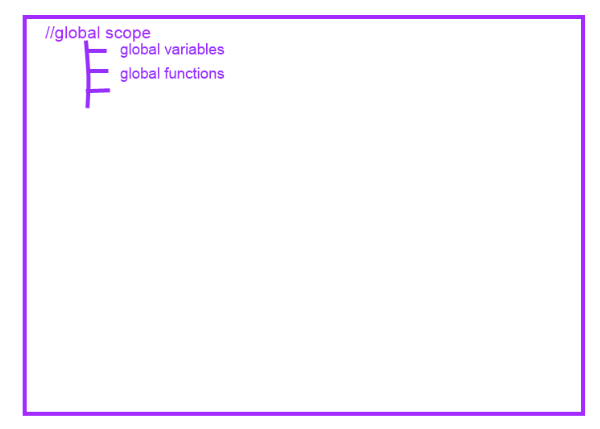
Local Scope
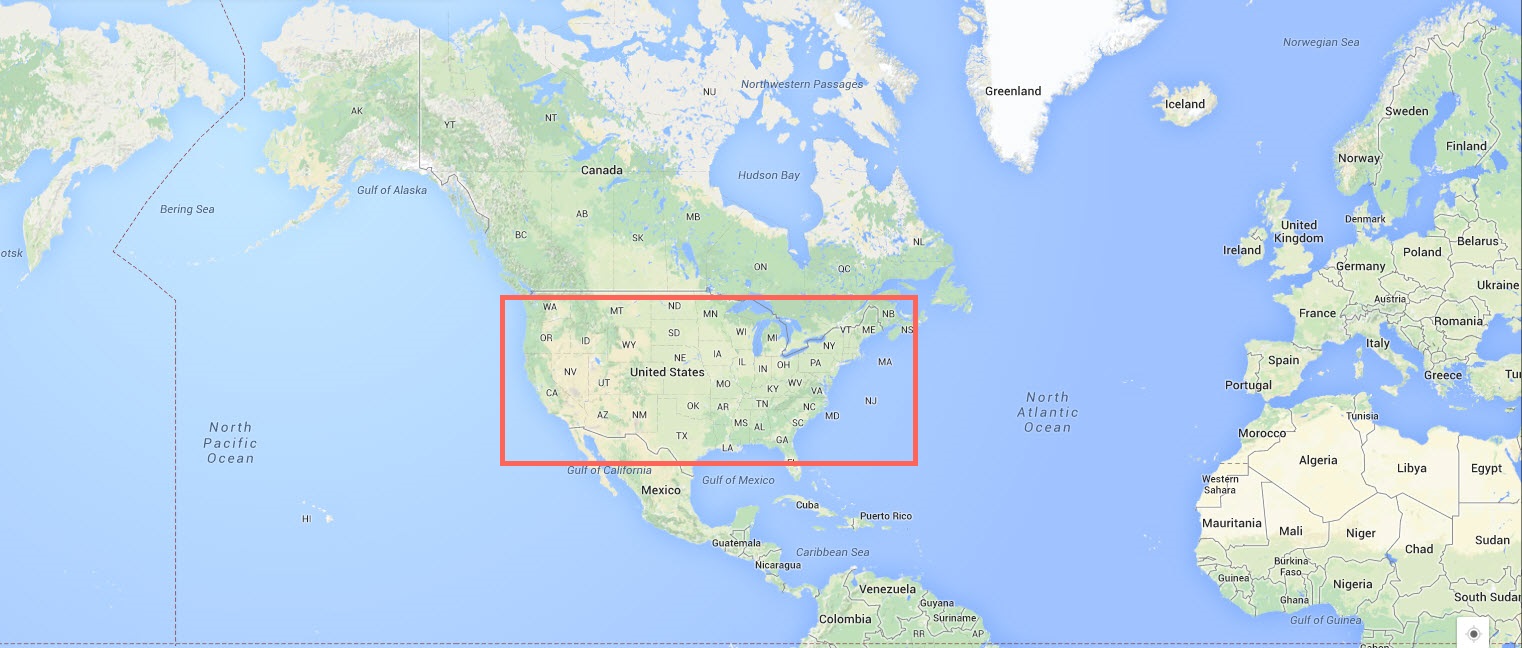


local/function scope
function b(){
var d = 21;
console.log(d);
}
b();
console.log(d); //ReferenceError: d is not defined
- function call creates execution context (before running any code)
- First thing created is the scope chain
- create arguments, variable, determine
this - execute function
JS scope chain
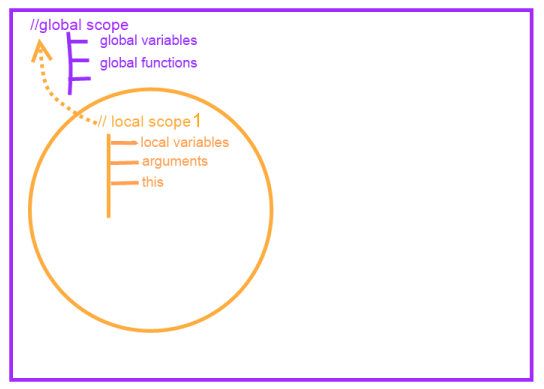
multi execution context
var a = 2;
function b(){ console.log(a); }
function c(){ console.log(a); }
b();
c();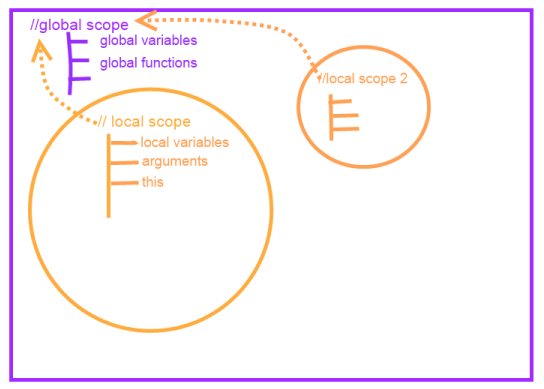
local events


nested function (closure)
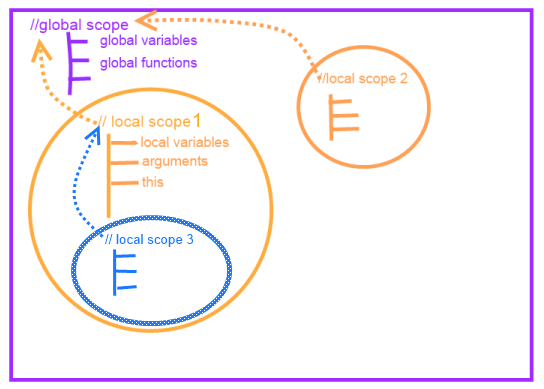
scope chain
is a collection of
what you need to know about block scope- let
closure

function in a function
function counter(){
var i = 0;
return function(){
return i++;
}
}
var a = counter();
a;
//function (){
// return i++;
// }
a();
function inside function
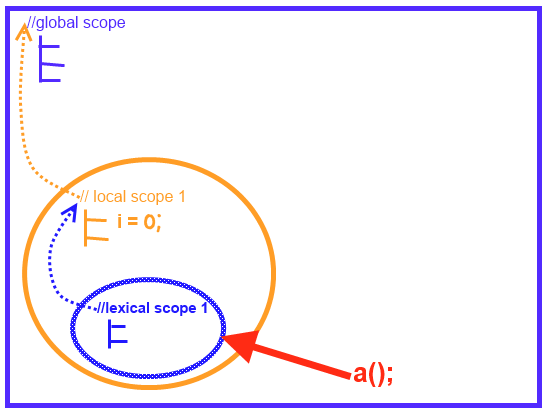
multiple closure
function counter(){
var i = 0;
return function(){
return i++;
}
}
var a = counter();
a(); //0
a(); //1
a(); //2
a(); //3
a(); //4
a(); //5multiple closure
var b = counter();
b(); //0
b(); //1
b(); //2
b(); //3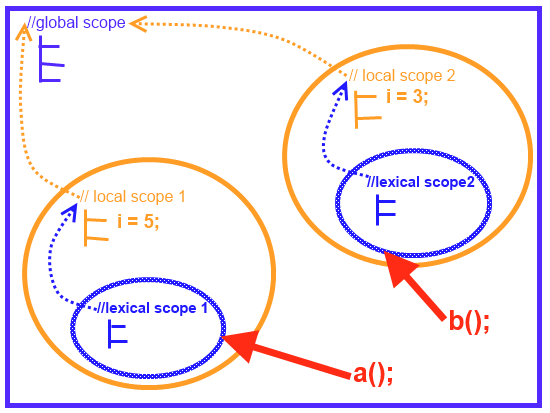
each closure have separate private variable
Who care?
- garbage collector can not claim the variable you are holding
- How many closure you are creating
- variable reference: Dont use excessively large private variable
- Unnecessary closure affect processing speed and memory consumption
Addy Osmani: memory efficient JS
Summary
- function inside another function
- doesn't have to return function
- Refer to variables, parameters outside of current scope
- read and write outer scope variable
- each closure has separate private variable
arguments

Local variable, available to all functions
function foo(a, b){
return arguments;
}
foo(); //[]
foo('js', 'is', 'fun'); //['js', 'is', 'fun']
- can't explicity created
- available only when function begin execution
- arguments & named parameters references same value
- updateing arguments[i] changes named parameters
Like an Array
arguments.length; //3
arguments[2]; //fun
Not an Array
arguments.indexOf('is');
//TypeError: Object has no method 'indexOf'
Convert to Array
var args = Array.prototype.slice.call(arguments);
args.map();
Don't mess up with names
function foo(a, arguments) {
return arguments;
};
foo(1); //undefined
function foo(a, b) {
var arguments = 43;
return arguments
};
foo(1, 2); //43
wake him up

summary
- function could have properties
- two stages of function call: Creation, Execution
- ExecutionContext: Scope chain, variableObj, this
- Jackie Chan, Kim Kardashian, super bowl
- Scope chain: collection of current + all parent Execution context
- Closure: save states and create encapsulation
- arguments: is an array like object
- Don't create a variable or parameter named arguments
morning of a developer










hoisting




hoist variable
function foo(){
console.log(a);
//do something
var a = 42;
}
foo();
//undefined
function foo(){
var a;
console.log(a);
//do something
a = 42;
}
function justLooping() {
for (var i = 0; i < 5; i++) {
//do something
}
console.log(i);
}
function justLooping() {
var i;
for (i = 0; i < 5; i++) {
//do something
}
console.log(i);
}
let's look into inner function
function outer(){
inner();
//do something else
function inner(){
console.log('inside inner function');
}
}
outer(); // inside inner function
function outer(){
function inner(){
console.log('inside inner');
}
//do something
inner();
}
function expression
function outer(){
inner();
//do something else
var inner = function(){
console.log('inside inner');
}
}
outer();//TypeError: undefined is not a function
function outer(){
var inner;
inner();
//do something else
inner = function(){
console.log('inside inner');
}
}this
What the heck is "this"?

What is this?
this;//window
function whatIsThis() {
return this;
}
whatIsThis(); //window
(function(){
return this;
})();
//window
(function(){
'use strict';
return this;
})(); //undefinedunderstand the context of execution
var a = {
b: function() {
return this;
}
};
a.b();//Object {b: function}
var foo = a.b;
var foo = function(){
return this;
};
foo(); //windowwindow.foo(); //window
var d = {};
d.c = a.b;
d.c();//Object {c: function}
constructor
this = {}
newly constructed object
function Friend(name) {
this.name = name;
this.context = this;
}
var frnd1 = new Friend('js dude');
var frnd2 = new Friend('common guy');
frnd1.name; //js dude
frnd1.context;//Friend {name: "js dude", context: Friend}
frnd2.name; //common guy
frnd2.context;//Friend {name: "common guy", context: Friend}
prototype chain
access property, methods in the prototype chain
var dad = {
fathersName:'big Dad'
}
var child = Object.create(dad);
child.whoIsYourFather = function(){
return this.fathersName;
}
child.whoIsYourFather(); //big Dad
child.hasOwnProperty('fathersName'); //false
Object.getPrototypeOf(child); //{fathersName: "big Dad"}
setTimeout inside constructor
function Menu(item){
this.item = item;
this.context = this;
setTimeout(function(){
console.log('setTimeout context:', this);
}, 10);
}
var lunch = new Menu('pizza');
//setTimeout context: window
lunch.context//Menu {item: "pizza", context: Menu}
Same issues with setInterval
"this" in arguments
8 ES5 function allows thisArg
Function.prototype.bind( thisArg [ , arg1 [ , arg2, ... ] ] )
Function.prototype.call( thisArg [ , arg1 [ , arg2, ... ] ] )
Function.prototype.apply( thisArg, argArray )



DOM event handler
this = element the event fired from
function bluify(e){
console.log(this === e.currentTarget); // Always true
console.log(this === e.target);// true when currentTarget and target are the same object
this.style.backgroundColor = '#A5D9F3';
}
//execute it in console
document.getElementById('myButton').addEventListener('click', function(){
console.log(this);
}, false);
same for inline element this
MDN: thisNow. I know this
- left of dot(.) will indicate value of this
- window (no dot)
- undefined (strict mode IIFE)
- object (left of dot('.') for a method call)
- newly constructed object (constructor: new keyword)
- window (inside setTimeout)
- element fired the event, inside event handler
- this has access to all inherited properties
- use bind, call, apply to set value of this explicitly
Day of a programmer

time wasted at work




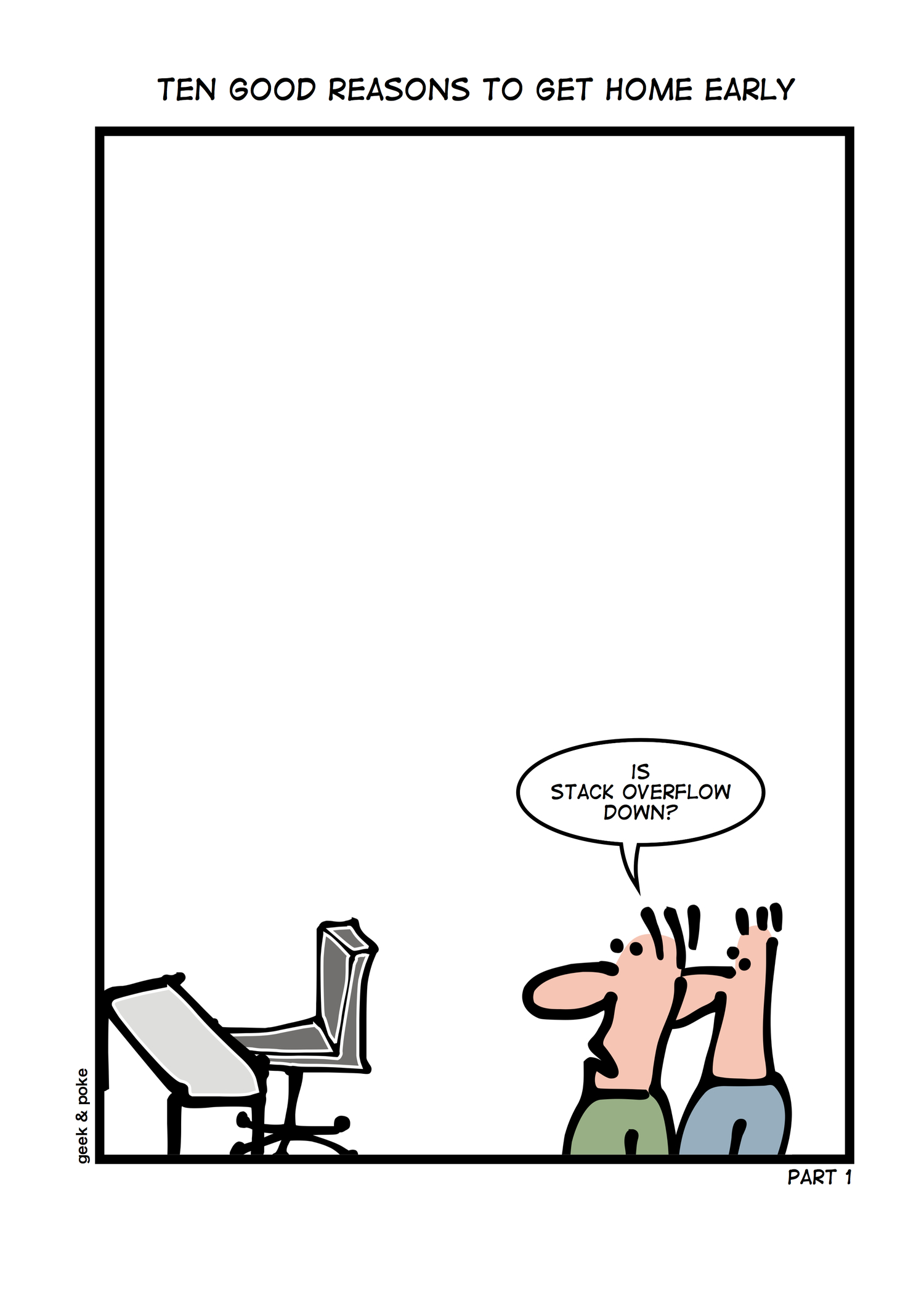



pass by
primitive by value
function foo(a){
a = 55;
}
var a = 7;
foo(a);
a; //7
primitive types: boolean, string, number
object is pass by ref
function foo(speaker){
speaker.name = 'Paul Irish';
}
var speaker = {name : 'Addy Osmani'};
foo(speaker);
console.log(speaker);//Object {name : "Paul Irish"}
replace object parameter
function foo(speaker){
speaker = {name : 'Paul Irish'};
}
var speaker = {name : 'Addy Osmani'};
foo(speaker);
console.log(speaker);//Object {name : "Addy Osmani"}
Call by Sharing
- If u change the parameter, it wont affect
- If u change INTERNALS, changes will propagate
call by sharing
by Ref, check this one
What is JavaScript?

How JavaScript works?
a single-threaded, non-blocking, asnchronous concurrent runtime
I am a programmer, give me detail
maintain a call stack, event loop, queue, etc.
are these in JS?
no. they are in JavaScript implementation.
Help, I'm stuck in an event-loop
what is call stack?
function multiply(a,b){
return a * b;
}
function square (n){
return multiply(n,n);
}
function consoleSquare(n){
var squared = square(n);
console.log(squared);
}
consoleSquare(3);
MDN: event loop
event loop explained
get out of there

Summary
- two stages of function call: creation, execution
- ExecutionContext: scope chain, variable Object, this
- Scope chain: collection of current + all parent Execution context
- Closure: Save states and create encapsulation
- left side of "." helps to defines values of this
- use bind, call, apply to set value of this explicitly
- changing properties of passed object will propagate
- JS Implementation: call stack, event loop, queue
Deleted Scenes
only 50 min
- inheritance
- types, boolean, array, +, equality
- problem with typeof
- timer
- strict mode
- promise
- small caveats like dot, comma, etc.
- dating with JS
- regex
Need more !!!
Frequently misunderstood JS Conceptsu reuined JS
JS comma
JS parts i struggled to remember.
Angus ES6
Free tip
Look Busy at Work
- Ctrl + 1 when big brother is around
- Use headphone or mute
- Always carry extra bag and print out
- do ur personal work, but leave after ur manager
- always leave a extra jacket on your chair
- compose email during office hours, send it midnight or weekends
Look busy

One thing
left side of dot (.) helps to define value of this
foo();
//window.foo();
a.b();
Thank You
MD Khan / @mdkhan005
www.thatJSdude.com
(youtube.com/user/khanLearning)Question?

goo.gl/dV2puW